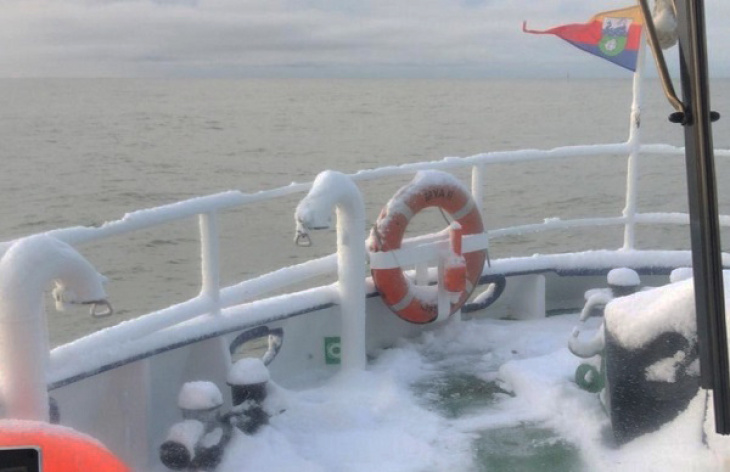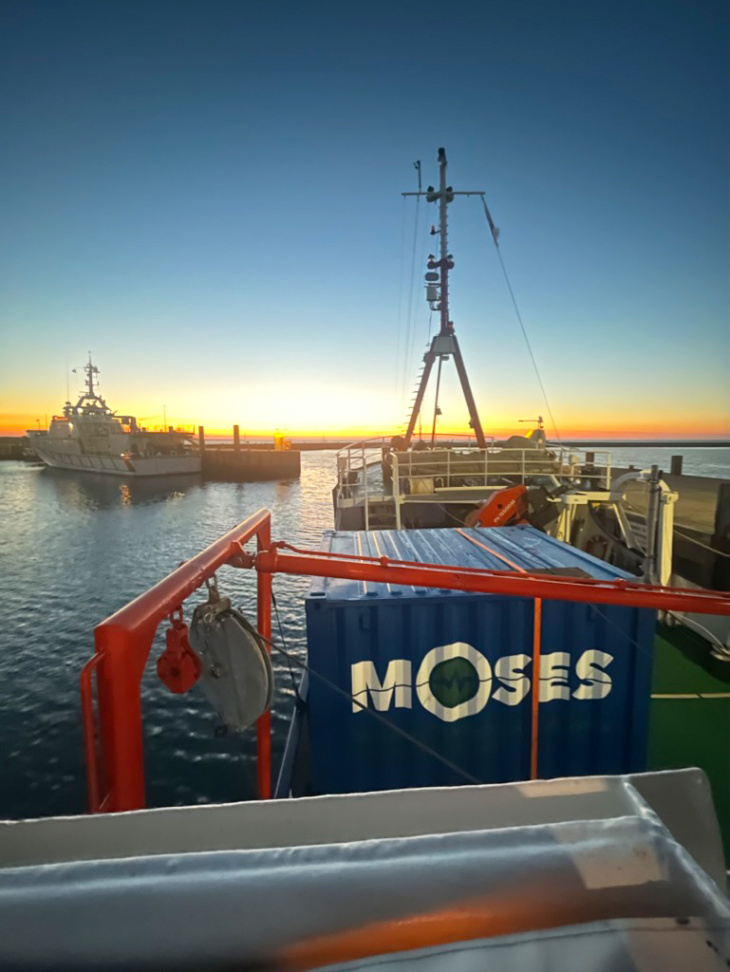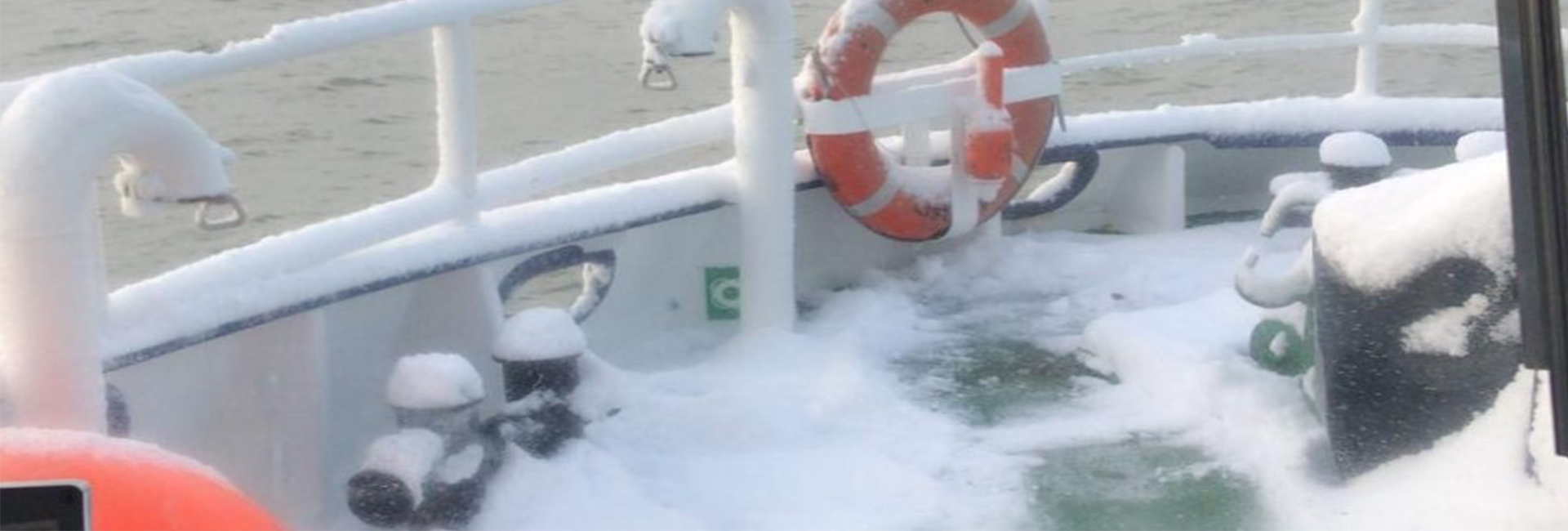Spontaneous winter expedition
The flood wave that has rolled down the Elbe into the North Sea since Christmas has been monitored and sampled by researchers from four Helmholtz Centers in a coordinated effort - a rare opportunity to study its effects on the river and estuary. The data obtained will help to better understand future risks and make predictions. The Helmholtz-Zentrum Hereon is also involved.

The researchers traced the “footprint” of the flood. Photo: AWI/ Ingeborg Bußmann
Helmholtz researchers have been investigating the condition of the Elbe from its source to its mouth for several years as part of the MOSES (Modular Observation Solutions for Earth Systems) measurement program. From this year, the new ElbeXtreme project will focus on extreme events as part of the mareXtreme research mission of the German Marine Research Alliance (DAM).
Now, before the turn of the year, there was a rare opportunity to carry out the investigations during a flood event. An ad hoc MOSES campaign was launched during the Christmas holidays in 2023, which tracked and sampled the flood wave from the Czech border to its mouth in the North Sea. The Helmholtz-Zentrum Hereon, the Helmholtz Centre for Environmental Research (UFZ), the Geomar Helmholtz Centre for Ocean Research Kiel and the Alfred-Wegener-Institut Helmholtz-Zentrum für Polar- und Meeresforschung (AWI) are involved in this campaign.
The question was: How do extreme events such as floods change the composition of the water? The investigations included measurements of conductivity and water temperature using sensor probes. At the same time, water samples were taken and analyzed in the laboratory for biogeochemical parameters such as carbon compounds, greenhouse gases, nutrients, micropollutants, metals and pigments. How these and other components dissolved in river water change with different water levels, is still one of the unsolved key questions in coastal and marine research.
From Bad Schandau to Cuxhaven
From the beginning of the flood at the end of December, researchers led by Dr Norbert Kamjunke from the UFZ followed the peak of the flood wave from land for eight days: from Bad Schandau on the German-Czech border to Lauenburg near Hamburg. Access to the river was often difficult due to the flooding of the Elbe River banks, so most of the samples were taken from bridges along the course of the river.
Downstream of the Geesthacht weir, the Hereon researchers took over the flood wave monitoring in the tidal Elbe. Despite the short lead time, their investigations were actively supported by the Hamburg Port Authority (HPA) and the Glückstadt-Wischhafen ferry company (FRS), which made the targeted sampling along the tidal river possible in the first place, says Hereon physicist Dr Götz Flöser.
On the trail of fresh water

The MOSES container - the basis for collecting the data. Photo: GEOMAR/ Björn Raupers
Following the arrival of the flood wave at Cuxhaven at the Elbe mouth in mid-January, AWI researchers continued the observations. They followed the expansion of the flood wave with the research vessel MYA II in the Elbe estuary to sample the same substances as in the Elbe.
GEOMAR then took over the final section: the sampling of the German Bight. On Helgoland, this week the LITTORINA will take the fully equipped MOSES laboratory container on board. The container has been specially developed for the project and will be transferred from ship to ship fully assembled. This means that the measuring sensors are standardized.
In addition to salinity, the MOSES/ ElbeXtreme team will spend a week taking samples at various locations for a variety of nutrients and pollutants, including trace elements and mercury, as well as greenhouse gases such as CO2 and methane, which were transported into the North Sea by the flood. DNA traces of organisms will also be examined.
It is planned to continue sampling the flood wave’s further spreading in the German Bight in the coming weeks. "It is particularly interesting to understand whether such extreme events also have long-term effects on our coastal system," says Dr Holger Brix, head of the MOSES/ ElbeXtreme project at Hereon.
Research hat to respond
The fact that the year 2024, when the ElbeXtreme project starts, begins with this special data collection is a great opportunity from a scientific perspective. Dr Ingeborg Bußmann, project manager at the AWI: "After the past extreme low water situations, we can now start our project with the collection of an unprecedented data set of flood events." The collected data will help to better understand future risks and make more reliable predictions.
Extreme flooding and low water events are likely to occur more frequently in the future due to climate change. Researchers therefore need to understand the impact of these events and their consequences for ecosystems. As part of ElbeXtreme, findings on the impact of these events on socio-ecological systems are being collected and adaptation and mitigation options are being developed in consultation with stakeholders.
Background
MOSES stands for "Modular Observation Solutions for Earth Systems". In this initiative coordinated by the UFZ, nine research centers of the Helmholtz Association have jointly set up mobile and modular observation systems between 2017 and 2021 to investigate the effects of temporally and spatially limited dynamic events such as extreme precipitation and runoff events or droughts on the long-term development of earth and environmental systems.
Starting this year, the ElbeXtreme project coordinated by GEOMAR will investigate the effects of physical-oceanographic extreme events on ecosystem services in the Elbe estuary. It is part of the research mission "Towards improved risk management in the area of marine extreme events and natural hazards (mareXtreme)" of the Deutsche Allianz Meeresforschung (DAM), an alliance of German marine research with the federal government and the northern German states of Bremen, Hamburg, Mecklenburg-Vorpommern, Niedersachsen and Schleswig-Holstein, funded by the Bundesministerium für Bildung und Forschung (BMBF).
Further Information
Website GEOMAR Helmholtz-Zentrum für Ozeanforschung Kiel Website Helmholtz-Zentrum für Polar- und Meeresforschung (AWI) Website Helmholtz-Zentrum für Umweltforschung (UFZ) Website Deutsche Allianz Meeresforschung (DAM) Website MOSES (Modular Observation Solutions for Earth Systems – Modulare Beobachtungslösungen für Erdsysteme) Website Hereon-Institut für Kohlenstoff-Kreisläufe
Contact
Head of Department Global Coast
Institute of Carbon Cycles
Phone: +49 (0) 4152 87-1523
